Rama Shanker1, Kamlesh Kumar Shukla1, Ravi Shanker2, Tekie Asehun Leonida3
1Department of Statistics, Eritrea Institute of Technology, Asmara, Eritrea
2Department of Mathematics, G.L.A. College, N.P University, Daltonganj, Jharkhand, India
3Department of Applied Mathematics, University of Twente, Enschede, The Netherlands
Correspondence to: Rama Shanker, Department of Statistics, Eritrea Institute of Technology, Asmara, Eritrea.
| Email: |  |
Copyright © 2017 Scientific & Academic Publishing. All Rights Reserved.
This work is licensed under the Creative Commons Attribution International License (CC BY).
http://creativecommons.org/licenses/by/4.0/

Abstract
A three-parameter Lindley distribution, which includes some two-parameter Lindley distributions introduced by Shanker and Mishra (2013 a, 2013 b), Shanker et al (2013), Shanker and Amanuel (2013), two-parameter gamma distribution, and one parameter exponential and Lindley distributions as special cases, has been proposed for modeling lifetime data. Its statistical properties including its shape, moments, skewness, kurtosis, hazard rate function, mean residual life function, stochastic ordering, mean deviations, order statistics, Renyi entropy measure, Bonferroni and Lorenz curves, stress-strength reliability have been discussed. For estimating its parameters, maximum likelihood estimation has been discussed. Finally, a numerical example has been presented to test the goodness of fit of the proposed distribution and the fit has been compared with the three-parameter generalized Lindley distribution.
Keywords:
Lindley distribution, Quasi Lindley distribution, Two-parameter Lindley distribution, Generalized Lindley distribution, Mathematical and Statistical properties, Moments, Maximum Likelihood estimation, Goodness of fit
Cite this paper: Rama Shanker, Kamlesh Kumar Shukla, Ravi Shanker, Tekie Asehun Leonida, A Three-Parameter Lindley Distribution, American Journal of Mathematics and Statistics, Vol. 7 No. 1, 2017, pp. 15-26. doi: 10.5923/j.ajms.20170701.03.
1. Introduction
The modeling and analyzing lifetime data are crucial in many applied sciences including medicine, engineering, insurance and finance, amongst others. During a short span of time a number of one parameter, two-parameter and three-parameter lifetime distributions have been introduced in statistical literature for modeling lifetime data from biomedical science and engineering. But each of these lifetime distributions has advantages and disadvantages over one another due to the number of parameters involved, shape, hazard rate function and mean residual life function, among others. Lindley (1958) distribution, introduced in the context of Bayesian analysis as a counter example of fiducial statistics, is defined by its probability density function (p.d.f) and cumulative distribution function (c.d.f)  | (1.1) |
 | (1.2) |
A detailed study about its important mathematical and statistical properties, estimation of parameter and application showing the superiority of Lindley distribution over exponential distribution for the waiting times before service of the bank customers has been done by Ghitany et al (2008). Shanker et al (2015) have comparative study on modeling of lifetime data using one parameter Lindley (1958) distribution and exponential distribution and concluded that there are many lifetime data where exponential distribution gives better fit than Lindley distribution. Sankaran (1970) obtained a Poisson mixture of Lindley distribution and named it discrete Poisson-Lindley distribution (PLD) and discussed its various properties, estimation of parameter and goodness of fit. Shanker and Hagos (2015) have introduced a simple method for estimating parameter of PLD and discussed its applications for modeling count data from biological sciences. The probability density function (p.d.f.) and cumulative distribution function (c.d.f) of quasi Lindley distribution (QLD) of Shanker and Mishra (2013a) are given by  | (1.3) |
 | (1.4) |
At  , both (1.3) and (1.4) reduce to the corresponding expressions (1.1) and (1.2) of Lindley distribution. Shanker and Mishra (2016) have obtained a Poisson mixture of a quasi Lindley distribution and named it a ‘quasi Poisson-Lindley distribution (QPLD)’ and discussed its various statistical and mathematical properties, estimation of parameters, and applications. Shanker et al (2016 a) have discussed many interesting properties of QLD and its applications for modeling various lifetime data and observed that it gives better fit in most of the data sets.The probability density function (p.d.f.) and cumulative distribution function (c.d.f) of two-parameter Lindley distribution (TPLD) of Shanker and Mishra (2013b) are given by
, both (1.3) and (1.4) reduce to the corresponding expressions (1.1) and (1.2) of Lindley distribution. Shanker and Mishra (2016) have obtained a Poisson mixture of a quasi Lindley distribution and named it a ‘quasi Poisson-Lindley distribution (QPLD)’ and discussed its various statistical and mathematical properties, estimation of parameters, and applications. Shanker et al (2016 a) have discussed many interesting properties of QLD and its applications for modeling various lifetime data and observed that it gives better fit in most of the data sets.The probability density function (p.d.f.) and cumulative distribution function (c.d.f) of two-parameter Lindley distribution (TPLD) of Shanker and Mishra (2013b) are given by  | (1.5) |
 | (1.6) |
At  , both (1.5) and (1.6) reduce to the corresponding expressions (1.1) and (1.2) of Lindley distribution. Shanker and Mishra (2014) have obtained a Poisson mixture of a two- Lindley distribution and named it a two-parameter Poisson-Lindley distribution and discussed its various statistical and mathematical properties, estimation of parameters, and applications. Shanker et al (2016 b) have discussed many interesting properties of TPLD and its applications for modeling various lifetime data and observed that it gives better fit in most of the data sets.The probability density function (p.d.f.) and cumulative distribution function (c.d.f) of another two-parameter Lindley distribution, introduced by Shanker et al (2013) are given by
, both (1.5) and (1.6) reduce to the corresponding expressions (1.1) and (1.2) of Lindley distribution. Shanker and Mishra (2014) have obtained a Poisson mixture of a two- Lindley distribution and named it a two-parameter Poisson-Lindley distribution and discussed its various statistical and mathematical properties, estimation of parameters, and applications. Shanker et al (2016 b) have discussed many interesting properties of TPLD and its applications for modeling various lifetime data and observed that it gives better fit in most of the data sets.The probability density function (p.d.f.) and cumulative distribution function (c.d.f) of another two-parameter Lindley distribution, introduced by Shanker et al (2013) are given by  | (1.7) |
 | (1.8) |
At  , both (1.7) and (1.8) reduce to the corresponding expressions (1.1) and (1.2) of Lindley distribution. Shanker et al (2012) obtained a Poisson mixture of two-parameter Lindley distribution, named it a ‘discrete two-parameter Poisson-Lindley distribution’ and studied its various properties, estimation of parameters and applications.The probability density function (p.d.f.) and cumulative distribution function (c.d.f) of a new quasi Lindley distribution (NQLD), introduced by Shanker and Amanuel (2013) are given by
, both (1.7) and (1.8) reduce to the corresponding expressions (1.1) and (1.2) of Lindley distribution. Shanker et al (2012) obtained a Poisson mixture of two-parameter Lindley distribution, named it a ‘discrete two-parameter Poisson-Lindley distribution’ and studied its various properties, estimation of parameters and applications.The probability density function (p.d.f.) and cumulative distribution function (c.d.f) of a new quasi Lindley distribution (NQLD), introduced by Shanker and Amanuel (2013) are given by  | (1.9) |
 | (1.10) |
Where  or
or  At
At  , both (1.9) and (1.10) reduce to the corresponding expressions (1.1) and (1.2) of Lindley distribution. Shanker and Tekie (2014) obtained a new quasi Poisson-Lindley distribution by taking a Poisson mixture of NQLD, discussed its various statistical and mathematical properties, estimation of parameters and applications for count data.The probability density function of three-parameter generalized Lindley distribution (TPGLD) introduced by Zakerzadeh and Dolati (2009) having parameters
, both (1.9) and (1.10) reduce to the corresponding expressions (1.1) and (1.2) of Lindley distribution. Shanker and Tekie (2014) obtained a new quasi Poisson-Lindley distribution by taking a Poisson mixture of NQLD, discussed its various statistical and mathematical properties, estimation of parameters and applications for count data.The probability density function of three-parameter generalized Lindley distribution (TPGLD) introduced by Zakerzadeh and Dolati (2009) having parameters  is given by
is given by | (1.11) |
Clearly the gamma distribution, the Lindley (1958) distribution and the exponential distribution are particular cases of (2.1) for  respectively. The discussion about its properties, estimation of parameters and applications are available in Zakerzadeh and Dolati (2009). The corresponding distribution function of the TPGLD can be obtained as
respectively. The discussion about its properties, estimation of parameters and applications are available in Zakerzadeh and Dolati (2009). The corresponding distribution function of the TPGLD can be obtained as | (1.12) |
where  is the upper incomplete gamma function defined as
is the upper incomplete gamma function defined as Recently Shanker (2016) has detailed study about TPGLD and obtained expressions for coefficient of variation, skewness, kurtosis, index of dispersion, hazard rate function and the mean residual life function. Shanker (2016) has detailed comparative study of TPGLD and three-parameter generalized gamma distribution (TPGGD) and observed that in most of the data sets from medical science and engineering TPGGD gives better fit than TPGLD.There are many situations where these distributions are not suitable for modeling lifetime data from theoretical or applied point of view. Therefore, an attempt has been made in this paper to obtain a new distribution which is flexible than these lifetime distributions for modeling lifetime data in reliability and in terms of its hazard rate shapes. Various interesting mathematical and statistical properties of the proposed distribution have been discussed. The estimation of the parameters of the proposed distribution has been discussed using maximum likelihood estimates and the goodness of fit of the distribution has been discussed with a real lifetime data. Finally the goodness of fit of the proposed distribution has been compared with three-parameter generalized Lindley distribution, introduced by Zakerzadeh and Dolati (2009).
Recently Shanker (2016) has detailed study about TPGLD and obtained expressions for coefficient of variation, skewness, kurtosis, index of dispersion, hazard rate function and the mean residual life function. Shanker (2016) has detailed comparative study of TPGLD and three-parameter generalized gamma distribution (TPGGD) and observed that in most of the data sets from medical science and engineering TPGGD gives better fit than TPGLD.There are many situations where these distributions are not suitable for modeling lifetime data from theoretical or applied point of view. Therefore, an attempt has been made in this paper to obtain a new distribution which is flexible than these lifetime distributions for modeling lifetime data in reliability and in terms of its hazard rate shapes. Various interesting mathematical and statistical properties of the proposed distribution have been discussed. The estimation of the parameters of the proposed distribution has been discussed using maximum likelihood estimates and the goodness of fit of the distribution has been discussed with a real lifetime data. Finally the goodness of fit of the proposed distribution has been compared with three-parameter generalized Lindley distribution, introduced by Zakerzadeh and Dolati (2009).
2. A Three-Parameter Lindley Distribution
The probability density function (p.d.f.) of a three- parameter Lindley distribution (ATPLD) can be introduced as | (2.1) |
It can be easily verified that the two-parameter quasi Lindley distribution of Shanker and Mishra (2013 a), two-parameter Lindley distribution of Shanker and Mishra (2013 b), two-parameter Lindley distribution of Shanker et al (2013), a new two-parameter quasi Lindley distribution of Shanker and Amanuel (2013), Lindley distribution introduced by Lindley (1958), Gamma  distribution and exponential distribution are particular cases of a three-parameter Lindley distribution (ATPLD) for
distribution and exponential distribution are particular cases of a three-parameter Lindley distribution (ATPLD) for 

 and
and  respectively.This distribution can be easily expressed as a mixture of exponential
respectively.This distribution can be easily expressed as a mixture of exponential  and gamma
and gamma  distributions with mixing proportion
distributions with mixing proportion  We have
We have where
where 
 and
and The corresponding cumulative distribution function (c.d.f.) of (2.1) is given by
The corresponding cumulative distribution function (c.d.f.) of (2.1) is given by  | (2.2) |
The graph of the p.d.f. and the c.d.f. of ATPLD for different values of  are shown in figures 1 and 2.
are shown in figures 1 and 2.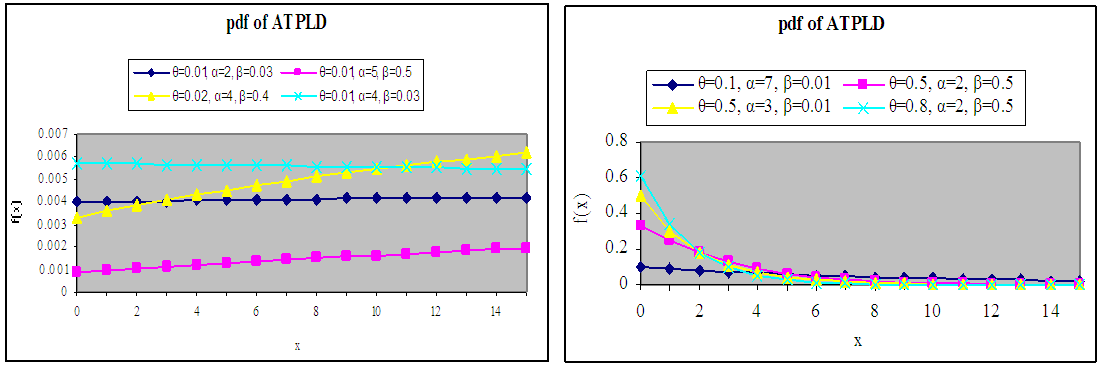 | Figure 1. Graph of the pdf of ATPLD for different values of parameters  |
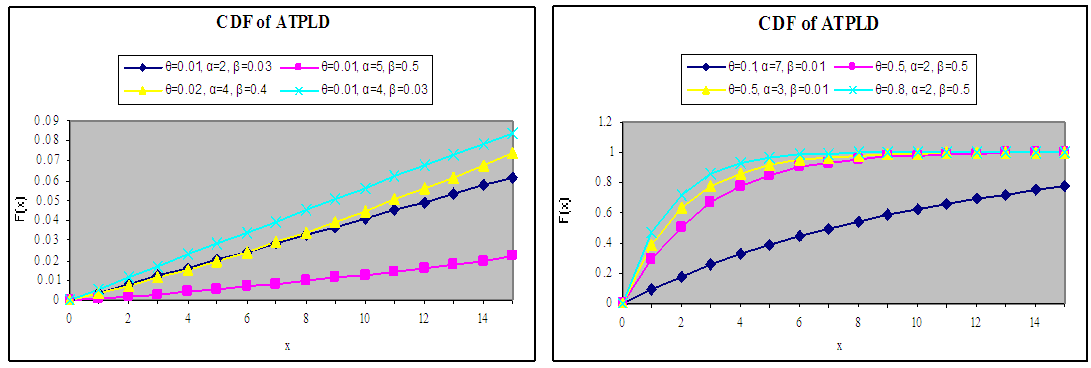 | Figure 2. Graph of the cdf of ATPLD for different values of parameters  |
3. Statistical Constants
The  moment about origin of ATPLD (2.1) can be obtained as
moment about origin of ATPLD (2.1) can be obtained as The first four moments about origin of ATPLD are as follows
The first four moments about origin of ATPLD are as follows
 Thus the moments about mean of ATPLD are obtained as
Thus the moments about mean of ATPLD are obtained as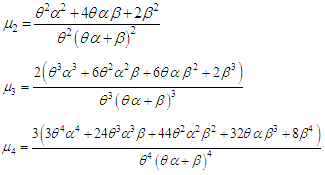 The coefficient of variation
The coefficient of variation coefficient of skewness
coefficient of skewness  coefficient of kurtosis
coefficient of kurtosis  and index of dispersion
and index of dispersion  of ATPLD are thus obtained as
of ATPLD are thus obtained as
4. Hazard Rate Function and Mean Residual Life Function
Let  and
and  be the p.d.f. and c.d.f of a continuous random variable. The hazard rate function (also known as the failure rate function) and the mean residual life function of
be the p.d.f. and c.d.f of a continuous random variable. The hazard rate function (also known as the failure rate function) and the mean residual life function of  are respectively defined as
are respectively defined as  | (4.1) |
and | (4.2) |
The corresponding hazard rate function,  and the mean residual life function,
and the mean residual life function,  of ATPLD are obtained as
of ATPLD are obtained as | (4.3) |
and  | (4.4) |
It can be easily verified that  and
and  It is also obvious from the graphs of
It is also obvious from the graphs of  and
and  that
that  is an increasing and decreasing functions of
is an increasing and decreasing functions of  and
and  whereas
whereas  is a decreasing function of
is a decreasing function of  and
and  The graph of the hazard rate function and mean residual life function of ATPLD are shown in figures 3 and 4.
The graph of the hazard rate function and mean residual life function of ATPLD are shown in figures 3 and 4.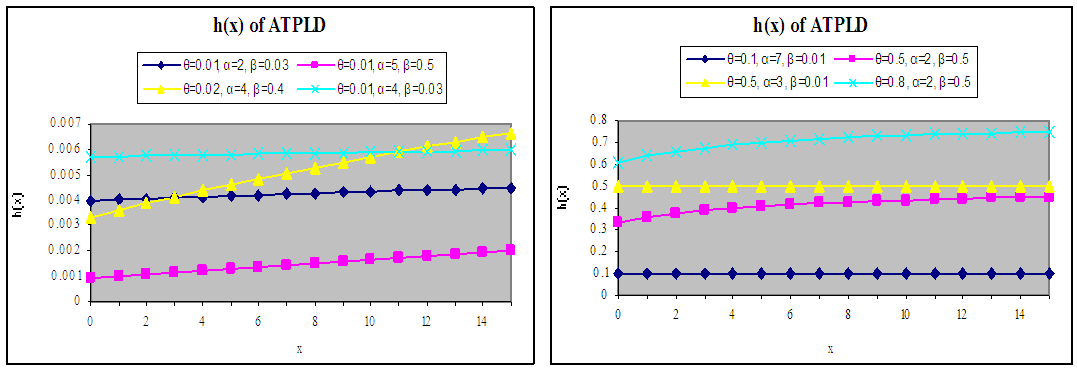 | Figure 3. Graph of hazard rate function of ATPLD for different values of parameters  |
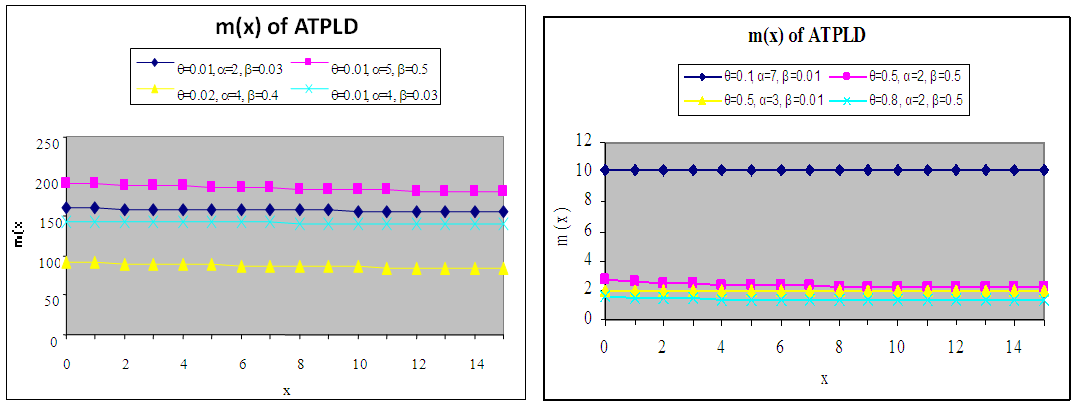 | Figure 4. Graph of mean residual life function of ATPLD for different values of parameters  |
5. Stochastic Orderings
Stochastic ordering of positive continuous random variables is an important tool for judging their comparative behavior. A random variable  is said to be smaller than a random variable
is said to be smaller than a random variable  in the (i) stochastic order
in the (i) stochastic order  if
if  for all
for all  (ii) hazard rate order
(ii) hazard rate order  if
if  for all
for all  (iii) mean residual life order
(iii) mean residual life order  if
if  for all
for all  (iv) likelihood ratio order
(iv) likelihood ratio order  if
if  decreases in
decreases in  The following results due to Shaked and Shanthikumar (1994) are well known for establishing stochastic ordering of distributions
The following results due to Shaked and Shanthikumar (1994) are well known for establishing stochastic ordering of distributions | (5.1) |
The ATPLD is ordered with respect to the strongest ‘likelihood ratio’ ordering as shown in the following theorem:Theorem: Let  and
and  Now under conditions (i)
Now under conditions (i)  (ii)
(ii)  and (iii)
and (iii)  and
and  and hence
and hence  and
and  Proof: We have
Proof: We have  Now
Now This gives
This gives  It can be easily verified that under conditions (1), (ii), and (iii),
It can be easily verified that under conditions (1), (ii), and (iii),  This means that
This means that  and hence
and hence  and
and 
6. Mean Deviations
The amount of scatter in a population is measured to some extent by the totality of deviations usually from mean and median. These are known as the mean deviation about the mean and the mean deviation about the median defined by and
and  respectively, where
respectively, where  and
and  The measures
The measures  and
and  can be calculated using the relationships
can be calculated using the relationships | (6.1) |
and 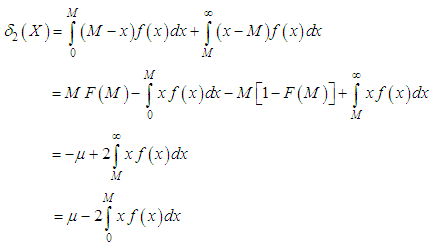 | (6.2) |
Using p.d.f. (2.1) and expression for the mean of ATPLD, we get | (6.3) |
 | (6.4) |
Using expressions from (6.1), (6.2), (6.3), and (6.4), the mean deviation about mean,  and the mean deviation about median,
and the mean deviation about median,  of ATPLD are obtained as
of ATPLD are obtained as | (6.5) |
 | (6.6) |
7. Bonferroni and Lorenz Curves
The Bonferroni and Lorenz curves (Bonferroni, 1930) and Bonferroni and Gini indices have applications not only in economics to study income and poverty, but also in other fields like reliability, demography, insurance and medicine. The Bonferroni and Lorenz curves are defined as | (7.1) |
 | (7.2) |
respectively or equivalently  | (7.3) |
 | (7.4) |
respectively, where  and
and  The Bonferroni and Gini indices are thus defined as
The Bonferroni and Gini indices are thus defined as | (7.5) |
 | (7.6) |
respectively.Using p.d.f. (2.1), we get  | (7.7) |
Now using equation (7.7) in (7.1) and (7.2), we get  | (7.8) |
 | (7.9) |
Now using equations (7.8) and (7.9) in (7.5) and (7.6), the Bonferroni and Gini indices of ATPLD are obtained as | (7.10) |
 | (7.11) |
8. Order Statistics and Renyi Entropy Measure
8.1. Order Statistics
Let  be a random sample of size
be a random sample of size  from ATPLD (2.1). Let
from ATPLD (2.1). Let  denote the corresponding order statistics. The p.d.f. and the c.d.f. of the
denote the corresponding order statistics. The p.d.f. and the c.d.f. of the  order statistic, say
order statistic, say  are given by
are given by and
and 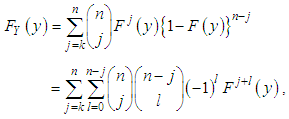 respectively, for
respectively, for  Thus, the p.d.f. and the c.d.f of
Thus, the p.d.f. and the c.d.f of  order statistics of ATPLD are obtained as
order statistics of ATPLD are obtained as and
and
8.2. Renyi Entropy Measure
An entropy of a random variable  is a measure of variation of uncertainty. A popular entropy measure is Renyi entropy (1961). If
is a measure of variation of uncertainty. A popular entropy measure is Renyi entropy (1961). If  is a continuous random variable having probability density function
is a continuous random variable having probability density function  then Renyi entropy is defined as
then Renyi entropy is defined as where
where  Thus, the Renyi entropy for ATPLD (2.1) can be obtained as
Thus, the Renyi entropy for ATPLD (2.1) can be obtained as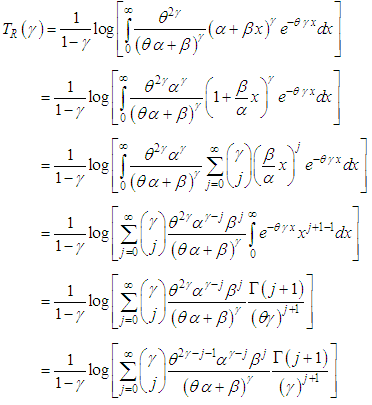
9. Stress-Strength Reliability
The stress- strength reliability describes the life of a component which has random strengththat is subjected to a random stress  When the stress applied to it exceeds the strength, the component fails instantly and the component will function satisfactorily till
When the stress applied to it exceeds the strength, the component fails instantly and the component will function satisfactorily till  Therefore,
Therefore,  is a measure of component reliability and in statistical literature it is known as stress-strength parameter. It has wide applications in almost all areas of knowledge especially in engineering such as structures, deterioration of rocket motors, static fatigue of ceramic components, aging of concrete pressure vessels etc.Let
is a measure of component reliability and in statistical literature it is known as stress-strength parameter. It has wide applications in almost all areas of knowledge especially in engineering such as structures, deterioration of rocket motors, static fatigue of ceramic components, aging of concrete pressure vessels etc.Let  and
and  be independent strength and stress random variables having ATPLD (2.1) with parameter
be independent strength and stress random variables having ATPLD (2.1) with parameter  and
and  respectively. Then the stress-strength reliability
respectively. Then the stress-strength reliability  of ATPLD can be obtained as
of ATPLD can be obtained as
10. Maximum Likelihood Estimate (MLE)
Let  be a random sample of size
be a random sample of size  from ATPLD (2.1). The likelihood function,
from ATPLD (2.1). The likelihood function,  of (2.1) is given by
of (2.1) is given by The natural log likelihood function is thus obtained as
The natural log likelihood function is thus obtained as The maximum likelihood estimates (MLE)
The maximum likelihood estimates (MLE)  and
and  and
and  are then the solutions of the following non-linear equations
are then the solutions of the following non-linear equations | (10.1.1) |
 | (10.1.2) |
 | (10.1.3) |
where  is the sample mean. The equation (10.1.1) gives
is the sample mean. The equation (10.1.1) gives  which is the mean of ATPLD (2.1). These three natural log likelihood equations do not seem to be solved directly. However, the Fisher’s scoring method can be applied to solve these equations. We have
which is the mean of ATPLD (2.1). These three natural log likelihood equations do not seem to be solved directly. However, the Fisher’s scoring method can be applied to solve these equations. We have The following equations can be solved for MLEs
The following equations can be solved for MLEs  and
and  of
of  and
and  of ATPLD
of ATPLD where
where  and
and  are the initial values of
are the initial values of  and
and  respectively. These equations are solved iteratively till sufficiently close values of
respectively. These equations are solved iteratively till sufficiently close values of  and
and  are obtained.
are obtained.
11. Goodness of Fit
A three-parameter Lindley distribution (ATPLD) has been fitted to a number of lifetime data to test its goodness of fit. In this section, we present the goodness of fit of ATPLD for a real lifetime data and its fit has been compared with the three-parameter generalized Lindley distribution (TPGLD), introduced by Zakerzadeh and Dolati (2009). The following lifetime data has been considered for testing the goodness of fit of ATPLD and TPGLD.Data Set: This data represents the survival times (in days) of 72 guinea pigs infected with virulent tubercle bacilli, observed and reported by Bjerkedal (1960) In order to compare ATPLD and TPGLD, values of
In order to compare ATPLD and TPGLD, values of  and K-S Statistics (Kolmogorov-Smirnov Statistics) for real life time data has been computed. The formulae for computing K-S Statistics is as follows:
and K-S Statistics (Kolmogorov-Smirnov Statistics) for real life time data has been computed. The formulae for computing K-S Statistics is as follows:  where
where  = the number of parameters,
= the number of parameters,  = the sample size and
= the sample size and  is the empirical distribution function. The best distribution is the distribution which corresponds to lower value of
is the empirical distribution function. The best distribution is the distribution which corresponds to lower value of  and K-S statistics and higher p-value.
and K-S statistics and higher p-value.Table 1. MLE’s, - 2ln L, AIC, AICC, BIC, and K-S Statistics of the fitted distributions of data
 |
| |
|
It can be easily seen from above table that ATPLD gives better fit than the TPGLD, introduced by Zakerzadeh and Dolati (2009).
12. Concluding Remarks
A three-parameter Lindley distribution (ATPLD) which includes two-parameter Lindley distributions introduced by Shanker and Mishra (2013 a, 2013 b) , Shanker et al (2013), Shanker and Amanuel (2013), two-parameter gamma distribution, and one parameter exponential and Lindley distributions, has been introduced for modeling lifetime data. Its mathematical and statistical properties including its shape, moments, skewness, kurtosis, hazard rate function, mean residual life function, stochastic ordering, mean deviations, order statistics, Renyi entropy measure, Bonferroni and Lorenz curves, stress-strength reliability have been discussed. For estimating its parameters, maximum likelihood estimation has been discussed. The goodness of fit of ATPLD has been found better than the goodness of fit given by TPGLD, and hence ATPLD can be considered an important lifetime distribution for modeling lifetime data over TPGLD.
ACKNOWLEDGEMENTS
The authors are grateful to the editor-in-chief of the journal and the anonymous reviewer for constructive comments which lead to the improvement in the quality of the paper.
References
| [1] | Bjerkedal, T. (1960): Acquisition of resistance in guinea pigs infected with different doses of virulent tubercle bacilli, American Journal of Epidemiology, 72 (1), 130 -148. |
| [2] | Bonferroni, C.E. (1930): Elementi di Statistca generale, Seeber, Firenze. |
| [3] | Ghitany, M.E., Atieh, B. and Nadarajah, S. (2008): Lindley distribution and its Application, Mathematics Computing and Simulation, 78, 493 – 506. |
| [4] | Lindley, D.V. (1958): Fiducial distributions and Bayes’ theorem, Journal of the Royal Statistical Society, Series B, 20, 102- 107. |
| [5] | Sankaran, M. (1970): The discrete Poisson-Lindley distribution, Biometrics, 26, 145 - 149. |
| [6] | Shaked, M. and Shanthikumar, J.G. (1994): Stochastic Orders and Their Applications, Academic Press, New York. |
| [7] | Shanker, R (2016): On generalized Lindley distribution and its applications to model lifetime data from biomedical science and engineering, to appear in, “Insights in Biomedicine”. |
| [8] | Shanker, R. and Mishra, A. (2013 a): A quasi Lindley distribution, African Journal of Mathematics and Computer Science Research, 6(4), 64 – 71. |
| [9] | Shanker, R. and Mishra, A. (2016): A quasi Poisson- Lindley distribution, to appear in Journal of Indian Statistical Association. |
| [10] | Shanker, R. and Mishra, A. (2013 b): A two-parameter Lindley distribution, Statistics in Transition-new series, 14 (1), 45- 56. |
| [11] | Shanker, R. and Mishra, A. (2014): A two-parameter Poisson-Lindley distribution, International Journal of Statistics and Systems, 9(1), 79 – 85. |
| [12] | Shanker, R., Sharma, S. and Shanker, R. (2013): A two-parameter Lindley distribution for modeling waiting and survival times data, Applied Mathematics, 4, 363 – 368. |
| [13] | Shanker, R., Sharma, S. and Shanker, R. (2012): A discrete two-parameter Poisson-Lindley distribution, Journal of Ethiopian Statistical Association, 21, 22 – 29. |
| [14] | Shanker, R. and Tekie, A.L. (2014): A new quasi Poisson-Lindley distribution, International Journal of Statistics and Systems, 9(1), 79 – 85. |
| [15] | Shanker, R. and Amanuel, A.G. (2013): A new quasi Lindley distribution, International Journal of Statistics and Systems, 8 (2), 143 – 156. |
| [16] | Shanker, R. and Hagos, F. (2015): On Poisson-Lindley distribution and its applications to biological Sciences, Biometrics & Biostatistics International Journal, 2(4), 1-5. |
| [17] | Shanker, R., Hagos, F, and Sujatha, S. (2015): On modeling of Lifetimes data using exponential and Lindley distributions, International Journal of Statistical distributions and Applications, 2(1), 1 - 7. |
| [18] | Shanker, R., Hagos, F. and Sharma, S. (2016 a): On quasi Lindley distribution and its Applications to Model Lifetime data, Biometrics & Biostatistics International Journal, 3(1), 1-8. |
| [19] | Shanker, R., Hagos, F. and Sharma, S. (2016 b): On Two-parameter Lindley distribution and its Applications to Model Lifetime data, Biometrics & Biostatistics International Journal, 3(1), 1-8. |
| [20] | Zakerzadeh, H. and Dolati, A. (2009): Generalized Lindley distribution, Journal of Mathematical extension, 3 (2), 13 – 25. |







 , both (1.3) and (1.4) reduce to the corresponding expressions (1.1) and (1.2) of Lindley distribution. Shanker and Mishra (2016) have obtained a Poisson mixture of a quasi Lindley distribution and named it a ‘quasi Poisson-Lindley distribution (QPLD)’ and discussed its various statistical and mathematical properties, estimation of parameters, and applications. Shanker et al (2016 a) have discussed many interesting properties of QLD and its applications for modeling various lifetime data and observed that it gives better fit in most of the data sets.The probability density function (p.d.f.) and cumulative distribution function (c.d.f) of two-parameter Lindley distribution (TPLD) of Shanker and Mishra (2013b) are given by
, both (1.3) and (1.4) reduce to the corresponding expressions (1.1) and (1.2) of Lindley distribution. Shanker and Mishra (2016) have obtained a Poisson mixture of a quasi Lindley distribution and named it a ‘quasi Poisson-Lindley distribution (QPLD)’ and discussed its various statistical and mathematical properties, estimation of parameters, and applications. Shanker et al (2016 a) have discussed many interesting properties of QLD and its applications for modeling various lifetime data and observed that it gives better fit in most of the data sets.The probability density function (p.d.f.) and cumulative distribution function (c.d.f) of two-parameter Lindley distribution (TPLD) of Shanker and Mishra (2013b) are given by 

 , both (1.5) and (1.6) reduce to the corresponding expressions (1.1) and (1.2) of Lindley distribution. Shanker and Mishra (2014) have obtained a Poisson mixture of a two- Lindley distribution and named it a two-parameter Poisson-Lindley distribution and discussed its various statistical and mathematical properties, estimation of parameters, and applications. Shanker et al (2016 b) have discussed many interesting properties of TPLD and its applications for modeling various lifetime data and observed that it gives better fit in most of the data sets.The probability density function (p.d.f.) and cumulative distribution function (c.d.f) of another two-parameter Lindley distribution, introduced by Shanker et al (2013) are given by
, both (1.5) and (1.6) reduce to the corresponding expressions (1.1) and (1.2) of Lindley distribution. Shanker and Mishra (2014) have obtained a Poisson mixture of a two- Lindley distribution and named it a two-parameter Poisson-Lindley distribution and discussed its various statistical and mathematical properties, estimation of parameters, and applications. Shanker et al (2016 b) have discussed many interesting properties of TPLD and its applications for modeling various lifetime data and observed that it gives better fit in most of the data sets.The probability density function (p.d.f.) and cumulative distribution function (c.d.f) of another two-parameter Lindley distribution, introduced by Shanker et al (2013) are given by 

 , both (1.7) and (1.8) reduce to the corresponding expressions (1.1) and (1.2) of Lindley distribution. Shanker et al (2012) obtained a Poisson mixture of two-parameter Lindley distribution, named it a ‘discrete two-parameter Poisson-Lindley distribution’ and studied its various properties, estimation of parameters and applications.The probability density function (p.d.f.) and cumulative distribution function (c.d.f) of a new quasi Lindley distribution (NQLD), introduced by Shanker and Amanuel (2013) are given by
, both (1.7) and (1.8) reduce to the corresponding expressions (1.1) and (1.2) of Lindley distribution. Shanker et al (2012) obtained a Poisson mixture of two-parameter Lindley distribution, named it a ‘discrete two-parameter Poisson-Lindley distribution’ and studied its various properties, estimation of parameters and applications.The probability density function (p.d.f.) and cumulative distribution function (c.d.f) of a new quasi Lindley distribution (NQLD), introduced by Shanker and Amanuel (2013) are given by 

 or
or  At
At  , both (1.9) and (1.10) reduce to the corresponding expressions (1.1) and (1.2) of Lindley distribution. Shanker and Tekie (2014) obtained a new quasi Poisson-Lindley distribution by taking a Poisson mixture of NQLD, discussed its various statistical and mathematical properties, estimation of parameters and applications for count data.The probability density function of three-parameter generalized Lindley distribution (TPGLD) introduced by Zakerzadeh and Dolati (2009) having parameters
, both (1.9) and (1.10) reduce to the corresponding expressions (1.1) and (1.2) of Lindley distribution. Shanker and Tekie (2014) obtained a new quasi Poisson-Lindley distribution by taking a Poisson mixture of NQLD, discussed its various statistical and mathematical properties, estimation of parameters and applications for count data.The probability density function of three-parameter generalized Lindley distribution (TPGLD) introduced by Zakerzadeh and Dolati (2009) having parameters  is given by
is given by
 respectively. The discussion about its properties, estimation of parameters and applications are available in Zakerzadeh and Dolati (2009). The corresponding distribution function of the TPGLD can be obtained as
respectively. The discussion about its properties, estimation of parameters and applications are available in Zakerzadeh and Dolati (2009). The corresponding distribution function of the TPGLD can be obtained as
 is the upper incomplete gamma function defined as
is the upper incomplete gamma function defined as Recently Shanker (2016) has detailed study about TPGLD and obtained expressions for coefficient of variation, skewness, kurtosis, index of dispersion, hazard rate function and the mean residual life function. Shanker (2016) has detailed comparative study of TPGLD and three-parameter generalized gamma distribution (TPGGD) and observed that in most of the data sets from medical science and engineering TPGGD gives better fit than TPGLD.There are many situations where these distributions are not suitable for modeling lifetime data from theoretical or applied point of view. Therefore, an attempt has been made in this paper to obtain a new distribution which is flexible than these lifetime distributions for modeling lifetime data in reliability and in terms of its hazard rate shapes. Various interesting mathematical and statistical properties of the proposed distribution have been discussed. The estimation of the parameters of the proposed distribution has been discussed using maximum likelihood estimates and the goodness of fit of the distribution has been discussed with a real lifetime data. Finally the goodness of fit of the proposed distribution has been compared with three-parameter generalized Lindley distribution, introduced by Zakerzadeh and Dolati (2009).
Recently Shanker (2016) has detailed study about TPGLD and obtained expressions for coefficient of variation, skewness, kurtosis, index of dispersion, hazard rate function and the mean residual life function. Shanker (2016) has detailed comparative study of TPGLD and three-parameter generalized gamma distribution (TPGGD) and observed that in most of the data sets from medical science and engineering TPGGD gives better fit than TPGLD.There are many situations where these distributions are not suitable for modeling lifetime data from theoretical or applied point of view. Therefore, an attempt has been made in this paper to obtain a new distribution which is flexible than these lifetime distributions for modeling lifetime data in reliability and in terms of its hazard rate shapes. Various interesting mathematical and statistical properties of the proposed distribution have been discussed. The estimation of the parameters of the proposed distribution has been discussed using maximum likelihood estimates and the goodness of fit of the distribution has been discussed with a real lifetime data. Finally the goodness of fit of the proposed distribution has been compared with three-parameter generalized Lindley distribution, introduced by Zakerzadeh and Dolati (2009).
 distribution and exponential distribution are particular cases of a three-parameter Lindley distribution (ATPLD) for
distribution and exponential distribution are particular cases of a three-parameter Lindley distribution (ATPLD) for 

 and
and  respectively.This distribution can be easily expressed as a mixture of exponential
respectively.This distribution can be easily expressed as a mixture of exponential  and gamma
and gamma  distributions with mixing proportion
distributions with mixing proportion  We have
We have where
where 
 and
and The corresponding cumulative distribution function (c.d.f.) of (2.1) is given by
The corresponding cumulative distribution function (c.d.f.) of (2.1) is given by 
 are shown in figures 1 and 2.
are shown in figures 1 and 2.



 moment about origin of ATPLD (2.1) can be obtained as
moment about origin of ATPLD (2.1) can be obtained as The first four moments about origin of ATPLD are as follows
The first four moments about origin of ATPLD are as follows
 Thus the moments about mean of ATPLD are obtained as
Thus the moments about mean of ATPLD are obtained as The coefficient of variation
The coefficient of variation coefficient of skewness
coefficient of skewness  coefficient of kurtosis
coefficient of kurtosis  and index of dispersion
and index of dispersion  of ATPLD are thus obtained as
of ATPLD are thus obtained as
 and
and  be the p.d.f. and c.d.f of a continuous random variable. The hazard rate function (also known as the failure rate function) and the mean residual life function of
be the p.d.f. and c.d.f of a continuous random variable. The hazard rate function (also known as the failure rate function) and the mean residual life function of  are respectively defined as
are respectively defined as 

 and the mean residual life function,
and the mean residual life function,  of ATPLD are obtained as
of ATPLD are obtained as

 and
and  It is also obvious from the graphs of
It is also obvious from the graphs of  and
and  that
that  is an increasing and decreasing functions of
is an increasing and decreasing functions of  and
and  whereas
whereas  is a decreasing function of
is a decreasing function of  and
and  The graph of the hazard rate function and mean residual life function of ATPLD are shown in figures 3 and 4.
The graph of the hazard rate function and mean residual life function of ATPLD are shown in figures 3 and 4.



 is said to be smaller than a random variable
is said to be smaller than a random variable  in the (i) stochastic order
in the (i) stochastic order  if
if  for all
for all  (ii) hazard rate order
(ii) hazard rate order  if
if  for all
for all  (iii) mean residual life order
(iii) mean residual life order  if
if  for all
for all  (iv) likelihood ratio order
(iv) likelihood ratio order  if
if  decreases in
decreases in  The following results due to Shaked and Shanthikumar (1994) are well known for establishing stochastic ordering of distributions
The following results due to Shaked and Shanthikumar (1994) are well known for establishing stochastic ordering of distributions
 and
and  Now under conditions (i)
Now under conditions (i)  (ii)
(ii)  and (iii)
and (iii)  and
and  and hence
and hence  and
and  Proof: We have
Proof: We have  Now
Now This gives
This gives  It can be easily verified that under conditions (1), (ii), and (iii),
It can be easily verified that under conditions (1), (ii), and (iii),  This means that
This means that  and hence
and hence  and
and 
 and
and  respectively, where
respectively, where  and
and  The measures
The measures  and
and  can be calculated using the relationships
can be calculated using the relationships



 and the mean deviation about median,
and the mean deviation about median,  of ATPLD are obtained as
of ATPLD are obtained as





 and
and  The Bonferroni and Gini indices are thus defined as
The Bonferroni and Gini indices are thus defined as






 be a random sample of size
be a random sample of size  from ATPLD (2.1). Let
from ATPLD (2.1). Let  denote the corresponding order statistics. The p.d.f. and the c.d.f. of the
denote the corresponding order statistics. The p.d.f. and the c.d.f. of the  order statistic, say
order statistic, say  are given by
are given by and
and  respectively, for
respectively, for  Thus, the p.d.f. and the c.d.f of
Thus, the p.d.f. and the c.d.f of  order statistics of ATPLD are obtained as
order statistics of ATPLD are obtained as and
and
 is a measure of variation of uncertainty. A popular entropy measure is Renyi entropy (1961). If
is a measure of variation of uncertainty. A popular entropy measure is Renyi entropy (1961). If  is a continuous random variable having probability density function
is a continuous random variable having probability density function  then Renyi entropy is defined as
then Renyi entropy is defined as where
where  Thus, the Renyi entropy for ATPLD (2.1) can be obtained as
Thus, the Renyi entropy for ATPLD (2.1) can be obtained as
 When the stress applied to it exceeds the strength, the component fails instantly and the component will function satisfactorily till
When the stress applied to it exceeds the strength, the component fails instantly and the component will function satisfactorily till  Therefore,
Therefore,  is a measure of component reliability and in statistical literature it is known as stress-strength parameter. It has wide applications in almost all areas of knowledge especially in engineering such as structures, deterioration of rocket motors, static fatigue of ceramic components, aging of concrete pressure vessels etc.Let
is a measure of component reliability and in statistical literature it is known as stress-strength parameter. It has wide applications in almost all areas of knowledge especially in engineering such as structures, deterioration of rocket motors, static fatigue of ceramic components, aging of concrete pressure vessels etc.Let  and
and  be independent strength and stress random variables having ATPLD (2.1) with parameter
be independent strength and stress random variables having ATPLD (2.1) with parameter  and
and  respectively. Then the stress-strength reliability
respectively. Then the stress-strength reliability  of ATPLD can be obtained as
of ATPLD can be obtained as
 be a random sample of size
be a random sample of size  from ATPLD (2.1). The likelihood function,
from ATPLD (2.1). The likelihood function,  of (2.1) is given by
of (2.1) is given by The natural log likelihood function is thus obtained as
The natural log likelihood function is thus obtained as The maximum likelihood estimates (MLE)
The maximum likelihood estimates (MLE)  and
and  and
and  are then the solutions of the following non-linear equations
are then the solutions of the following non-linear equations


 is the sample mean. The equation (10.1.1) gives
is the sample mean. The equation (10.1.1) gives  which is the mean of ATPLD (2.1). These three natural log likelihood equations do not seem to be solved directly. However, the Fisher’s scoring method can be applied to solve these equations. We have
which is the mean of ATPLD (2.1). These three natural log likelihood equations do not seem to be solved directly. However, the Fisher’s scoring method can be applied to solve these equations. We have The following equations can be solved for MLEs
The following equations can be solved for MLEs  and
and  of
of  and
and  of ATPLD
of ATPLD where
where  and
and  are the initial values of
are the initial values of  and
and  respectively. These equations are solved iteratively till sufficiently close values of
respectively. These equations are solved iteratively till sufficiently close values of  and
and  are obtained.
are obtained.  In order to compare ATPLD and TPGLD, values of
In order to compare ATPLD and TPGLD, values of  and K-S Statistics (Kolmogorov-Smirnov Statistics) for real life time data has been computed. The formulae for computing K-S Statistics is as follows:
and K-S Statistics (Kolmogorov-Smirnov Statistics) for real life time data has been computed. The formulae for computing K-S Statistics is as follows:  where
where  = the number of parameters,
= the number of parameters,  = the sample size and
= the sample size and  is the empirical distribution function. The best distribution is the distribution which corresponds to lower value of
is the empirical distribution function. The best distribution is the distribution which corresponds to lower value of  and K-S statistics and higher p-value.
and K-S statistics and higher p-value. Abstract
Abstract Reference
Reference Full-Text PDF
Full-Text PDF Full-text HTML
Full-text HTML